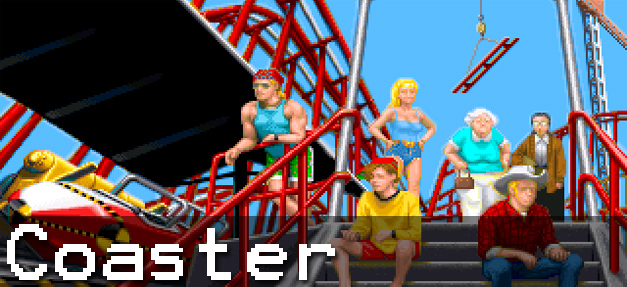
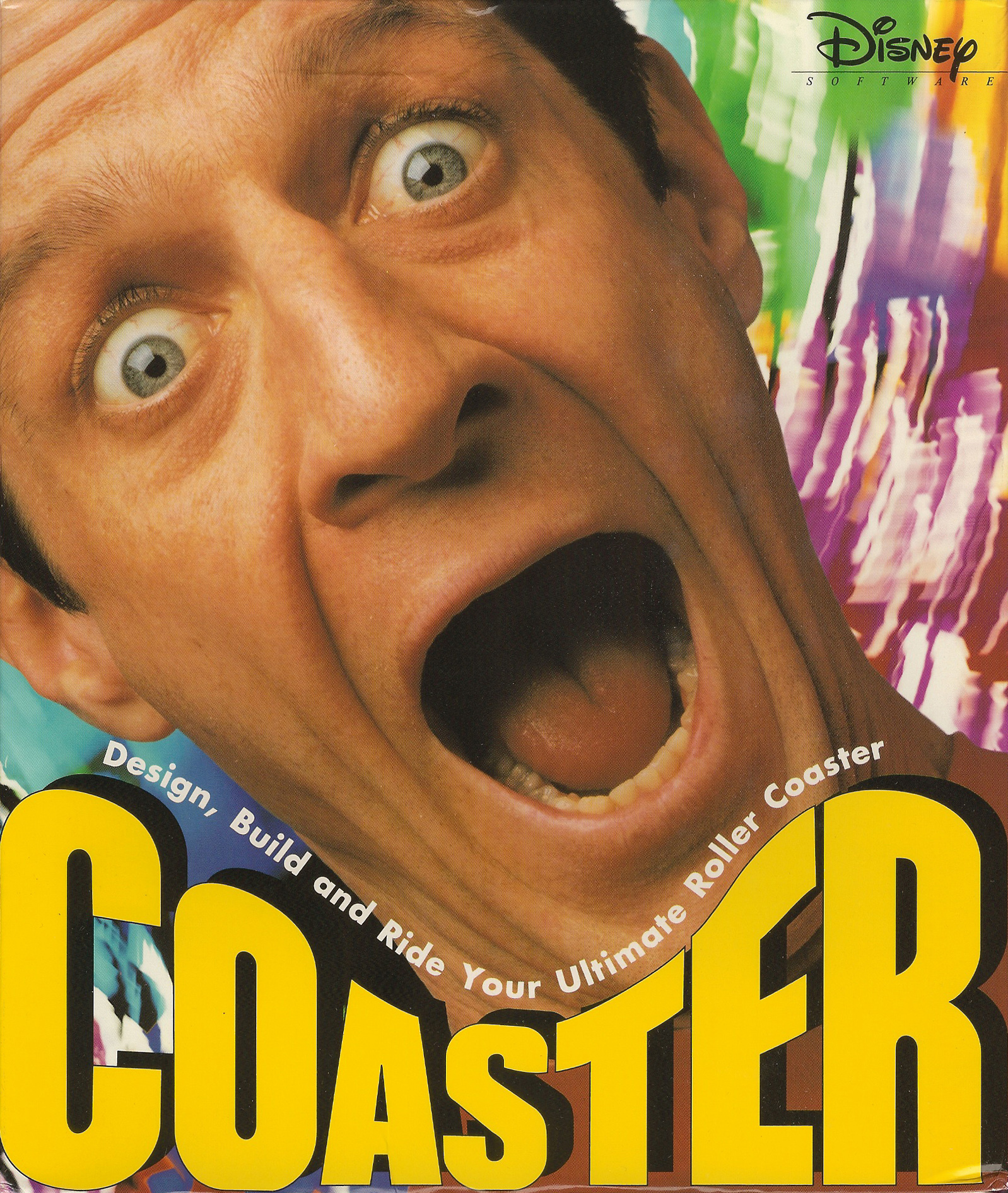 |
Coaster
Developer: Code To Go |
Steering far from what Disney Interactive Studios usually published for the time -- which were for the most part platformers for home consoles that were based on popular Disney films and TV shows -- they teamed up with a developer to release a few simulators that were cleverly disguised to look like games. Luckily one of them was really fun, at least from a creative standpoint. Released in 1993 for MS-DOS, Coaster allows the player to not only ride coasters, but to actually build them too!
The game always begins inside the office of a roller coaster engineer. From here the player controls a mouse pointer to select what they want to do. Click the mouse pad in the office to begin designing a coaster. To ride it, hover over and then click the glass door leading to a roller coaster shown in the distance. The final option is to exit the game by clicking the computer tower to the left of the desk.

A sort of signature for developer CTG was their beautifully designed 2D scenes. These drawings are often highly detailed and include a healthy amount lighting and shadowing to bring the scene to life. The office in Coaster is no exception as the desk is packed with computer gear and nick-nacks littering the room; one of which is a Mickey Mouse figurine! Another game from CTG that includes a similar kind of artistry throughout the game is Stunt Island, which is another game published by Disney Interactive Studios.
When designing a coaster, the player is greeted with a CAD styled interface. While this may be the most sterile of choices for a user interface, it is the cleanest way to have the player design a coaster in a 3D environment that includes building in all three axes (X, Y and Z). Construction begins by selecting the location of the station. The station platform is always at ground level and is the place where the ride begins and then ends, closing the circuit. Assisting in constructing roller coasters in this CAD program are a few windows that include a number of handy tools.
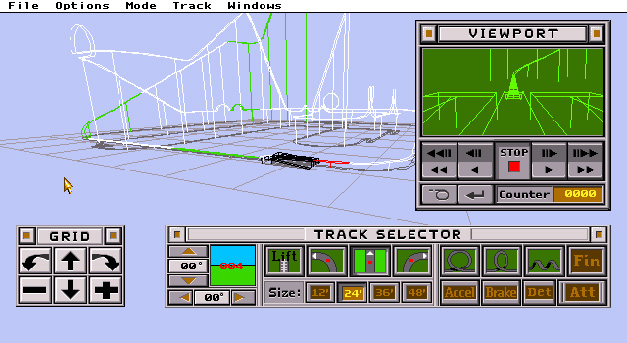
The Track Selector window is the primary toolkit for building your works of art. With it, you can pick different types of tracks such as loops, corkscrews, curves, and straight tracks. For certain tracks you can select the angle of how far it tilts to either the left or right to a maximum of 50 degrees, and for other tracks you can select the steepness of its ascent or descent. There is a special track called a lift that includes a chain system to pull the cars up a hill. And in case you didn't care about the physics of gravity while designing a ride, you can add accelerator and break systems to tracks to either speed up the cars or to slow them down.
Another window called Grid contains the controls to swing the camera around the 3D model of the coaster, angles it so you can look down on the coaster or see it at eye level, or zoom in and out. The third window titled Viewport is a video that shows how the ride would look from a rider's perspective. It includes playback controls to play, pause, fast-forward, rewind, and go frame-by-frame so every miniscule detail of the ride can be inspected before leaving the design environment.
Then, after spending hours on honing and crafting your sweet ride with just the right amount of loops and turns, drops and corkscrews, you can boogie on out of the office and actually ride it! Well, not just you by yourself but including a group of coaster enthusiasts that will come along and also rate it after riding it. The group consists of six riders that include a bull riding loving cowboy, a thrill seeking blonde, an adventurous grandma, a sideways hat wearing teenager who likes to go fast, a physics lovin' nerdette, and a dude-bro surfer. Each has a particular interest to coasters, so if you want a high score from the group, then you'll have to consider what each likes and implement them into your design.
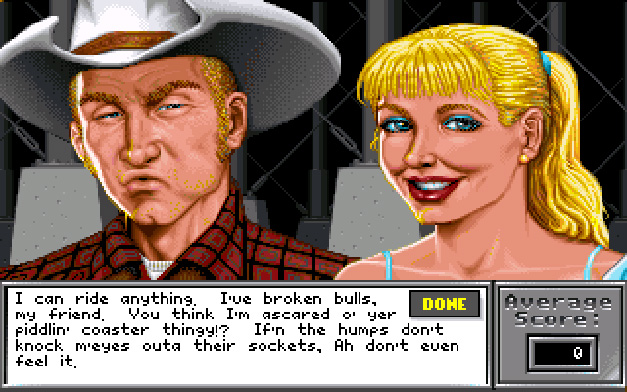
While at the coaster's platform, you can make some last minute adjustments before riding. For example, the break system can be adjusted to be either hard or soft, or for the accelerators to be fast or slow. Heck, weird changes like the gravity can be altered between Earth's, the Moon's, or Jupiter's. It is worth noting though, that these options and more can be changed back when designing a coaster, but saves you the hassle of going back to the design office, making one small change, saving it, and then returning to the platform to ride it.
When riding the coaster, you are always in the front seat to view your baby without any obstructions from a first-person perspective. In addition, your seat has a control panel to operate in real-time while the coaster is moving in case things don't go as smoothly as expected when you were in the design phase. The breaks can be applied at any time by clicking and holding the left mouse button and thrust can be applied by clicking and holding the right mouse button. Gages will also show the measurements of your coaster in terms of time and length durations, its speed, and g-forces. The evaluators will also scream and shout during times when your coaster is giving them a thrill, like during a steep drop. Visually, the graphics are not polygonal, but instead use the trick of scaling sprites to give the illusion of a 3D world, but works well for what it conveys.
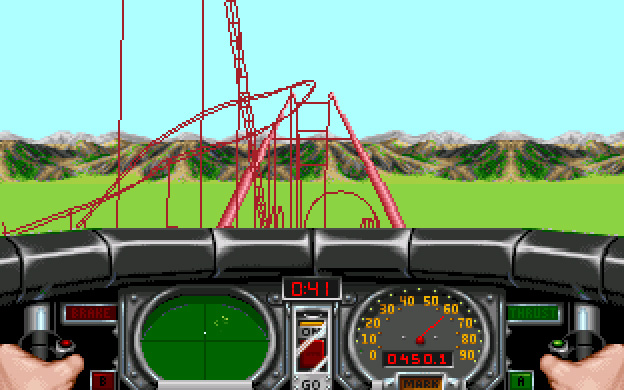
When the ride is over, go to the evaluators and listen to each person's opinion. Each rider will give a short description about how they felt about the experience. For a visual, their faces will show expressions from angry and disappointed to happy and dizzy. If the score is high enough, the coaster's name will be added to the game's Hall of Fame. If the scores were less than stellar, you can examine the science behind your ride by reviewing a system that monitors the lateral and vertical G's to compare it to other rides with higher scores to see what's different.
Oh yeah, you can ride a coaster before its finished being built. Meaning, the coaster can be ridden while there's still a gap in the track. Of course the evaluators, and you, won't actually ride it. Instead, crash test dummies will be used with the surfer guy saying, "We'll ride when this comes back in one piece." You'll still get to ride the coaster from the first-person perspective, but when the end of the track is reached, a short cutscene will show the car with the crash dummies in it flying through the sky and then plummeting to their demise; all the while a vulture witnesses this event and shakes its head in disgust when the head of one of the crash dummies bounces away after the harsh impact.

Coaster was pretty fun and unique for its time. Unfortunately it would be a while before we got something that was similar to it. Nearly ten years, in fact, is when a game comparable to it was released. Ultimate Ride came out for the PC back in 2001, and with it, a similar kind of build-it-and-ride-it workflow, but this time it was in polygonal 3D. In fact, Disney Interactive Studios teamed up with the developer, Gigawatt Studios, to make a Disney version called Ultimate Ride: Disney Coaster that was released in 2002 and included some of their own roller coasters like Big Thunder Mountain Railroad. Coaster may have been a simulator more than a game, but it was an entertaining one thanks in part to its simplistic tools for designing coasters and lighthearted humor when riding them.
Posted on: August 11, 2016
